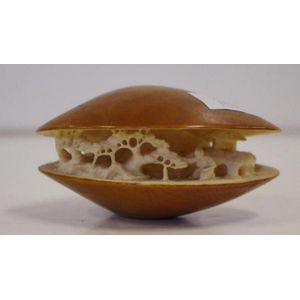Harry Davis' Sheep Landscape Porcelain Comport
You must be a subscriber, and be logged in to view price and dealer details.
Subscribe Now to view actual auction price for this item
When you subscribe, you have the option of setting the currency in which to display prices to $Au, $US, $NZ or Stg.
- Comport - A comport is a type of decorative serving dish or bowl, typically used for desserts, fruits or other sweet treats. The comport is usually made from glass, silver or porcelain, which are materials known for their elegance and durability. They are often beautifully designed and decorated, and can be used as an elegant and decorative centerpiece for a table or dining room. They are also widely used as a decorative piece on the mantelpiece, sideboard, or other areas of the house.
- Gilding - Gilding is a method of ornamentation whereby a thin sheet of gold metal is applied to items made of wood, leather, ceramics, glass and silver for decorative purposes.
For furniture including mirrors, the sheet of gold is usually applied over a coating of gesso. Gesso is a mixture of plaster of Paris and gypsum mixed with water and then applied to the carved wooden frames of mirrors and picture frames as a base for applying the gold leaf. After numerous coats of gesso have been applied, allowed to dry and then sanded a coat of "bole", a usually red coloured mixture of clay and glue is brushed on and allowed to dry, after which the gold leaf is applied. Over time parts of the gilding will rub off so the base colour can be seen. In water gilding, this was generally a blue colour, while in oil gilding, the under layer was often yellow. In Victorian times, gilders frequently used red as a pigment beneath the gold leaf.
Metal was often gilded by a process known as fire gilding. Gold mixed with mercury was applied and heated, causing the mercury to evaporate, the long-term effect of which was to kill or disable the craftsman or woman from mercury poisoning. The pursuit of beauty has claimed many victims, not the least of which were the artists who made those pieces so highly sought after today. - Firing Crack - A firing crack is a crack in a porcelain or stoneware item that occurs whilst the item is in the kiln.They are usually caused by faulty design, where one part is thicker than the surrounding area, and being thicker it cools more slowly, setting up a stress with the surrounding area. Firing cracks are not often seen on modern mass produced porcelain, as the damaged items are discarded during prooduction. However they are seen in earlier items and artisan-produced objects.
This item has been included into following indexes:
Visually similar items

Antique Wallendorf porcelain comport, 16 cm high, 27 cm diameter

Oriental carved ivory shell with figure and landscape carved decoration to inside of shell, signed to base

Mirek Smisek, footed table bowl with petal form rim, impressed mark, 33 cm diameter

Hammersley floral porcelain sweet set comprising a serving bowl, 6 dishes & cream jug. Plus a French porcelain tureen & saucer, all 20th century. (10 items)
